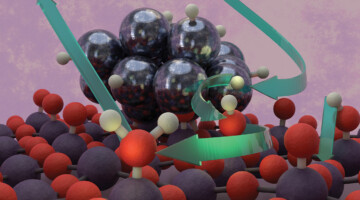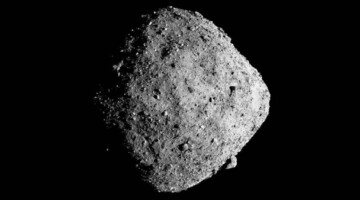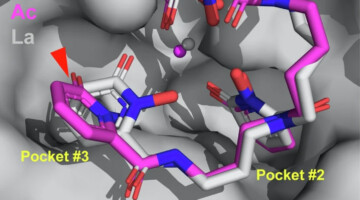A bimetallic material (Pd-Ni) produces hydrogen-active nanopockets that improve the efficiency and lower the cost of hydrogen storage systems. Mechanistic understanding of a Pd-Ni bimetallic system paves the way to design cost-effective hydrogen storage, opening new opportunities to develop reliable energy technologies necessary to advance the energy industry. Read more »![]()
![]()
Science Highlights
A New Twist for Superconductivity in Bilayer Graphene
In a study of twisted bilayer graphene (TBG) systems, researchers found intriguing spectroscopic features in a superconducting “magic-angle” TBG—features that are absent in non-superconducting TBG. The results provide crucial information on superconductivity in magic-angle TBG for next-gen electronics and advanced energy technologies. Read more »![]()
![]()
Catching “Hydrogen Spillover” onto a Catalytic Surface
Researchers uncovered the precise mechanism of hydrogen spillover (H2 splitting and migration) onto a catalytic surface by watching it happen under various conditions. The research lays the foundation for designing more efficient catalysts and storage materials essential for next-generation hydrogen energy technologies. Read more »![]()
![]()
Deep-Dive Inspection of a Molecular Assembly Line
By locking down certain movable parts of a modular drug-building protein, researchers learned new details about how carrier proteins transfer the product protein between modules. The results offer insights that could enable scientists to design and create new and improved medicines, such as antibiotics, using synthetic biology. Read more »![]()
![]()
Mapping the Quantum Landscape of Electrons in Solids
Researchers found a way to reconstruct quantum geometric tensors (QGTs)—mathematical entities that encode how an electron’s wave function is shaped by its quantum environment. The mapping of QGTs enables the discovery and control of novel quantum phenomena such as superconductivity and unconventional electronic phases. Read more »![]()
![]()
A Clearer Look at Lithium-Ion Traffic Jams in Batteries
By directly visualizing the uneven insertion of lithium ions into electrodes with well-defined crystal orientations, researchers learned why fast charging decreases battery lifespan and performance. The work could provide insights into better battery utilization and help investigations of the surface insertion reaction during fast charging. Read more »![]()
![]()
Bennu’s Ancient Brine Sheds Light on Recipe for Life
Researchers traced the evolution of minerals (“salts”) in an ancient brine, as recorded in samples from the asteroid Bennu, returned to Earth by NASA’s OSIRIS-REx mission. The results support the idea that asteroids like Bennu may have delivered water and essential chemical building blocks of life to Earth in the distant past. Read more »![]()
![]()
Understanding the Role of Manganese in Fuel Production Catalysts
Using specialized equipment at the Advanced Light Source (ALS), including a custom-built reaction cell, researchers uncovered the role of manganese in cobalt manganese oxide catalysts used for fuel production. Read more »![]()
![]()
Identification and Structural Characterization of Antibodies for Severe Malaria
Researchers used x-ray crystallography at the ALS to characterize how two newly discovered antibodies prevent the protein interactions responsible for severe malaria. Understanding this mechanism offers novel insights for vaccine development. Read more »![]()
![]()
A Macromolecular Scaffold for Probing Actinium Chemistry
By encapsulating actinium atoms within a macromolecular complex for analysis using protein crystallography, researchers discovered that actinium has a unique solid-state bonding configuration. A better understanding of actinium behavior could help improve a promising cancer treatment known as targeted alpha therapy. Read more »![]()
![]()
- « Previous Page
- 1
- 2
- 3
- 4
- …
- 27
- Next Page »









